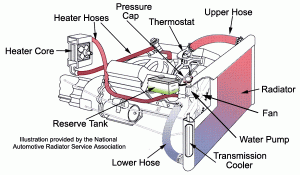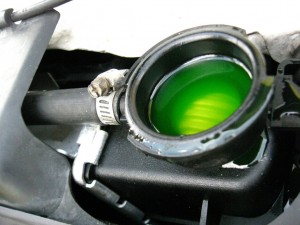Cooling System Flush – is it really necessary?
Posted August 18, 2014
Overheating is the most common cause of vehicle breakdowns and internal engine damage. As the heat rises in Littleton over the summer, our shop sees more and more people coming in after breakdowns due to cooling system failure. But there is an easy answer!
A cooling system flush can keep your engine running smooth and cool even on the hottest days. Regularly changing your coolant, aka antifreeze, can prevent larger problems for your cooling system and engine and keep your family safe on the road!
What is the Cooling System?
The cooling system is responsible for keeping your vehicle’s engine from overheating.  The engine runs best at a high temperature, so the cooling system helps it to heat up quickly then keep the engine at a regular, constant temperature without overheating as it runs. It accomplishes this by transferring heat into the air with the help of coolant, or antifreeze, and the other components of the cooling system.
The engine runs best at a high temperature, so the cooling system helps it to heat up quickly then keep the engine at a regular, constant temperature without overheating as it runs. It accomplishes this by transferring heat into the air with the help of coolant, or antifreeze, and the other components of the cooling system.
In most cars, the cooling system works by circulating radiator fluid (the mixture of coolant and water) through parts and pipes in the engine to absorb the heat and cool the engine. A radiator at the end of the system captures and transfers the heat from the fluid into the air.
But my coolant still looks clear, why should I change it?
New coolant usually appears a bright green or a bright red color, as in the picture below. As the coolant runs through the engine, rust and contaminants caused by oxidation and corrosion mix in with the fluid. Unfortunately, when you look under the hood to check your fluid, it may still appear clean and clear even though these contaminants rest under the surface, unseen and threatening the life of your engine.
 This video from Monday Morning Mechanic shows the striking visual of these hidden contaminants, and the threats they pose.
This video from Monday Morning Mechanic shows the striking visual of these hidden contaminants, and the threats they pose.
How often should I flush my coolant?
Most manufacturers recommend that you change the radiator fluid (the mixture of antifreeze coolant and water) every 24,000 to 36,000 miles or 24 to 36 months. Depending on your driving habits, you may need to flush your coolant more often – we recommend every 1-2 years.
Be leery of “extended life” coolants that tout 100,000 mile lifespans – even these can accumulate rust and contaminants that threaten your engine life. These impurities could add up and cause bigger problems before you reach the 100,000 mile check. Even with “extended life” fluids, you should have these coolants checked frequently.
What happens if I don’t?
Failing to change your coolant can take as much as 100,000 miles off the life of your engine, in addition to big problems and expensive repairs.
Coolant flows through your entire engine, leaving behind contaminants. They can collect on the radiator, inside the water pump or thermostat, getting stuck and preventing the components from working appropriately. Plastic components, like the water pump, can wear and break apart. If the water pump breaks, the system won’t be able to move the water and coolant through the engine. Hoses can also react to contaminants, becoming swollen and rusty on the inside even as they appear normal on the outside. With excess heat, belts that control the cooling system and steering will start cracking, eventually breaking and disabling the systems (imagine a steering belt break, not being able to control your vehicle!).
Bottom line – contaminated coolant can lead to cooling system failure, causing your engine to overheat and break down, leaving you stranded on the road!
We assume your family’s safety is at the top of your priority list, so having your coolant flushed or even just checked while it’s still scorching outside, and before it gets cold, should be as well. Avoid expensive engine breakdowns by having your coolant flushed before problems arise. Call us at 303-347-1010 or stop by our shop.
Categories: Car Care Tips
Tags: , coolant fluid, cooling system flush

